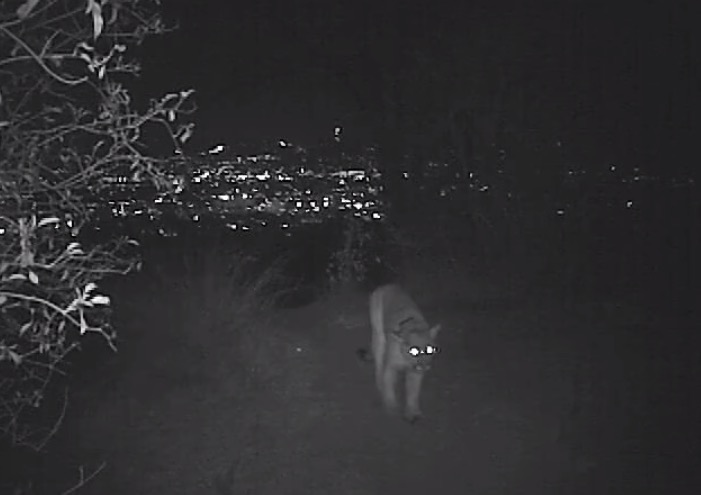A mountain lion named P-22 is making headlines today for being discovered inside — and eventually escaping from — a Los Angeles basement. In this excerpt from his new book about the urban wilderness,Tristan Donovan gives us the origin story of P-22.
The discovery of P-22, the mountain lion that lives in Griffith Park, was pure fluke. The park is part of the Santa Monica Mountains, but thanks to the Los Angeles sprawl it is cut off from the rest of the range by the Hollywood Freeway and urban development.
Griffith Park’s unusual status as an island of natural habitat in an ocean of development had long piqued the interest of biologists. Among them Miguel Ordeñana of the Natural History Museum of Los Angeles County. He was keen to find out if animals were travelling in and out of the park when the only safe routes to and fro were a few bridges and underpasses crossing the busy Hollywood Freeway.
To shed some light on this, Miguel put motion-detecting cameras around the park and the routes over US 101 to get photos of passing animals. He wasn’t looking for mountain lions.
“I was looking through the photos one afternoon, hoping to see a bobcat as that was the most rare, coolest thing at the time,” says Miguel. “I went through the photos and was really excited to see a bobcat in there.
“I was really pumped about that and then, all of a sudden, I go to the next photo and see a big mountain lion in the picture. It was just amazing. As soon as I saw it I contacted my collaborators and Laurel.”
Laurel Serieys had been helping out with a National Park Service project tracking mountain lions in the Santa Monicas. Like Miguel, she was shocked. “The park is too small for a normal mountain lion gang,” she says. “He most likely crossed two freeways to get there, and it is unusual to see a mountain lion crossing a major freeway successfully.”
Soon after, the National Park Service trapped the then three-year-old animal so they could give him a radio collar that would let them track his movements. They christened him P-22.
The park service has been following P-22 around Griffith Park ever since. One area of keen interest, given his proximity to the city, is his diet, so every week Laurel and Miguel have been heading into the park to check out locations where P-22 was hanging around for long periods to try to retrieve the remains of his kills.
They invited me along on one of their trips. The goal? To visit three suspected P-22 kill sites.

P-22 in a still from NHMLA’s 2013 video footage shot in Griffith Park
It’s a busy, hot Sunday morning when I join Laurel and Miguel at the park. The footpaths are filled with joggers and hikers, but we soon depart from the crowds to head into more rugged terrain.
As we struggle up a steep hill, I ask Laurel what they hope to learn from P-22’s leftovers. “A lot of people have misconceptions about what the wild animals are eating,” she says. “So it’s a general diet study to show that they are eating deer like they are supposed to, even in these very urban environments.”
Mountain lions prefer to eat deer and elk. In the Santa Ana Mountains on the other side of L.A., mule deer make up 95 per cent of what cougars eat. Coyotes account for another 4 per cent of their diet. Mountain lions very rarely prey on pets, even when they are readily available. Nor do they often venture close to houses.
“Mountain lions are not even getting close to people’s yards,” says Laurel. “So for the National Park Service mountain lion survey, the majority of the mountain lion locations they get from the radio collars are a kilometre away from even roads.”
So it’s something of a surprise when the third kill site of the day takes us out of Griffith Park and onto a road. After getting our bearings we figure out that the location is up the driveway of a large house. We head to the front door.
Laurel checks the map again. The site seems to lie right behind the house, although Laurel doesn’t think the kill happened in the backyard. “On the satellite images it looks like there’s more open space behind the property than we can see from here, but those images are a few years old so it’s hard to know exactly what is there.”
But there’s no way to find out without going through the house, and that’s a problem. After all, what is the etiquette for turning up on someone’s doorstep, plastered in dirt and dripping with sweat, to ask if you can see their backyard because you think a lion killed something right by their house?
After a short discussion, we decide to leave empty-handed.
On the way back, Miguel tells me how he hopes P-22 will make people less frightened about cougars living near cities. “The media likes to make these mountain lions seem very dangerous, but having P-22 right in this very urban area in a small park is a testament to how, even in these urban areas, they are not going to be like a coyote and start asking for food,” he says.
Picture: Photo by Steve Winter/National Wildlife Federation
Adapted with permission from Feral Cities: Adventures with Animals in the Urban Jungle by Tristan Donovan, published by Chicago Review Press.
